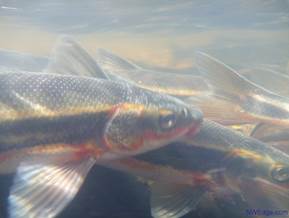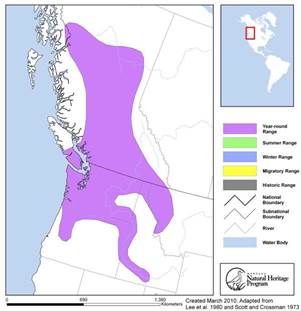..after we encamped a little Indian boy caugh several chubbs with a bone in this form which he substituted for a hook. these fish were of about 9 inches long small head large abdomen, small where the tail joined the body, the tail wide long in proportion and forked. the back and ventral fins were equadistant from the head and had each 10 bony rays, the f[i]ns next the gills nine each and that near the tail 12. the upper exceeded the under jaw, the latter is truncate at the extremity and the tongue and pallet are smooth. the colour is white on the sides and belley and a blewish brown on the back. the iris of the eye is of a silvery colour and puple black.. —-Merriweather Lewis, April 26, 1806. At the mouth of the Umatilla River, WA.
This is a small minnow native to the Pacific NW and found in British Columbia, Washington, Oregon, Idaho, and western Montana. Minnows are within the family Cyprinidae that include carp, the true minnows, and their relatives. Cyprinidae is the largest fish family and the largest vertebrate family with about 3,000 living and extinct species.
The peamouth is common throughout its range and is small, averaging 4-6 inches in length. It has a long snout and an overhanging mouth typical of many minnows, with a small barbell (protuberance or whisker-like thing) at the corners of the mouth. This small fish is brightly colored with localized areas of red at the angles of the mouth. Breeding fish of both sexes red lower lips and prominent red stripes on the side. Males have a green back and females a brownish back. Mature fish are a silvery color with two dark lateral stripes that diverge slightly towards the tail.

This fish is found in both rivers and lakes within its range. They will spawn in the shallow, warmer waters of the lake shoreline, in small creeks, and along the margins of larger rivers. It has a limited tolerance for brackish water, which may have helped it extend its range to Vancouver Island. In winter it tends to head for the deeper water of lakes and large rivers. Peamouth eat a variety of aquatic insects and their larvae such as mayflies, caddisflies, and chironomids. They also will prey upon smaller fish such as sculpins. Mylocheilus Greek, mylo – mill and cheilos, lip (so, mill-lip?) and caurinus from caurus, which means northwest wind, referring to its distribution.

Spawning occurs in waters about 54 degrees and here in Seattle they typically spawn Late April – Mid-May in Lake Washington and its tributaries. Spawning densities can be quite dense with 50 – 400 individuals – which often elicits calls to city or county officials from folks wondering what the heck is going on. Spawning is occurs in a compressed timeframe usually lasting from 24 to 48 hours and then that’s it until next year.
The City of Bellevue, along Lake Washington, here in Washington has a website devoted to peamouth and once used to send out alerts to let people know where they could see them spawning – but that page doesn’t seem to be active anymore. But the city still organizes the Peamouth Patrol that keeps taps on the spawning population. Females will be crowded by two or more males in a couple inches of water during spawning. Females drop green-gray adhesive eggs to the bottom where they will stick to rocks, logs, or other hard substrate. The eggs hatch pretty quickly – within 7 to 9 days.
In Seattle a good place to see them is in Thornton Creek, which empties into Lake Washington at Mathews Beach Park. I’ve seen them here in the early spring and it is quite to sight to see the densities of them clogging up the stream channel. They are a favorite prey item for mergansers, a fish-eating bird common along rivers. Other predators include mink, otter, raccoons, and larger fish.
Native Americans were known to catch the fish as indicated by the Merriweather Lewis quote at the beginning of this narrative. These quotes are dissected by ichthyologists to determine the taxonomy of the journal entry, and some arguments have erupted over the years as to the true identity of a referenced fish. For those with more interest in the subject: Adventures in Ichthyology
